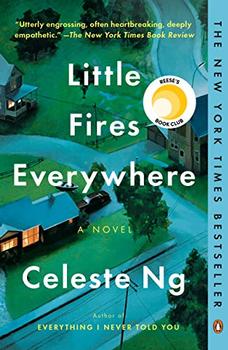Summary | Excerpt | Reviews | Beyond the book | Read-Alikes | Genres & Themes | Author Bio

Voted 2017 Best Fiction by BookBrowse's Subscribers
Small towns, big drama. Acclaimed author Celeste Ng's Little Fires Everywhere occasionally reads like an upscale television show, with multiple plot lines interweaving to create a delicate dissection of suburban America.
The novel begins when artist Mia Warren, and her teenage daughter Pearl, rent Elena Richardson's second home. From there, it shifts into two divergent but interlocking story lines – the clashes between foils Elena and Mia, and Pearl's coming-of-age interactions with the Richardson children. The book gains a new sense of gravity when Mia's coworker, Bebe Chow, engages in a high-profile custody clash to regain the rights to her baby, May Ling. The infant had been adopted by Elena's closest friend, Linda McCullough, a woman unable to have her own children. And while Bebe had abandoned her baby during a time of crisis, she is now in a more stable position and desperate to get her daughter back.
The struggle divides the picture-perfect town of Shaker Heights, Ohio (a suburb of Cleveland), into two, and sparks resentment between Mia and Elena, leading to unforeseen consequences. While the entire novel is written extremely well, in the first half the tropes are somewhat tired—struggling artist protagonist, overbearing mom and her rebellious daughter—and the plot slow-moving. What sets Little Fires Everywhere apart is the custody battle. Bebe's desperation to regain her daughter adds a layer of emotional depth to the exploration of racial microaggressions. She fights for the rights to regain her Chinese daughter from a white family who thinks dining out at their favorite Chinese restaurant is enough to connect May Ling to her culture.
Bebe's struggles also push several moral questions to the forefront of both Shaker Heights and the reader's mind. The press points out that Bebe did abandon her baby, and the McCullough family would provide May Ling a privileged life. Then again, Bebe acted out of a larger concern about her child's future, and the McCulloughs, while affluent and loving, would deprive May Ling of experiencing her own culture. Who is "right?"
Emotionally, the reader – or, at least this reader – feels for Bebe. Mia sums up Bebe's loss beautifully: "To a parent, your child wasn't just a person: your child was a place, a kind of Narnia, a vast eternal place where the present you were living and the past you remembered and the future you longed for all existed at once." However, by making Linda McCullough desperate for children and extremely doting, Ng avoids spelling out how the reader should react, and instead paints a picture and leaves you to interpret the details.
This sense of delicacy and expert crafting is also on display with the cast of characters. With so many different viewpoints—from the four Richardson children, to Mia and Pearl, to Elena Richardson—it would be easy for the various characters to blur together, but Ng infuses each with their own personality, voice, and growth. I found myself perfectly okay with the multiplicity of voices. While it is the youngest Richardson child, Izzy, who is the most enchanting from the start—what with her black-sheep label, and her refusal to fit into the conventional Shaker Heights stereotypes – it is her older sister Lexie who surprised me the most. Arrogant and self-absorbed, Lexie also displays appealing hints of vulnerability. I wanted to know what other surprises she would serve up.
All the characters feel lifelike and balanced – everyone has their own strengths and flaws, and you sympathize even with the antagonists. Mia Warren and Elena Richardson are at opposite ends of the spectrum personality-wise – the former, artistic, eccentric, kind-hearted, spontaneous; the latter, grounded, ritualistic, scheming, determined—and their interactions form a subtle tension throughout the book, leaving the readers to wonder what cataclysmic event their polite animosity will lead up to.
Some of the story's plot does seem derivative. Even if this is not a novel for teens, the sections that feature Pearl and the Richardson children include many familiar tropes of young adult dramas – unrequited and requited love, teenage angst, the value and tensions of friendships, loners contrasted against the popular folk. Still, with its expertly done characterization, beautiful and often poignant writing, and subtle examination of suburban America, Little Fires Everywhere fills the reader with emotions and questions that linger long after the last page is finished.
![]() This review was originally published in The BookBrowse Review in September 2017, and has been updated for the
June 2019 edition.
Click here to go to this issue.
This review was originally published in The BookBrowse Review in September 2017, and has been updated for the
June 2019 edition.
Click here to go to this issue.

If you liked Little Fires Everywhere, try these:

by Alina Grabowski
Published 2025
A gripping literary puzzle that unwinds the private lives of ten women as they confront tragedy in a small Massachusetts town.

by Lindsay Hunter
Published 2024
The third title in Roxane Gay Books' inaugural list, Hot Springs Drive is an urgent, vicious blade of a novel about a shocking betrayal and its aftermath, asking just how far you'll go to have everything you want
Your guide toexceptional books
BookBrowse seeks out and recommends the best in contemporary fiction and nonfiction—books that not only engage and entertain but also deepen our understanding of ourselves and the world around us.